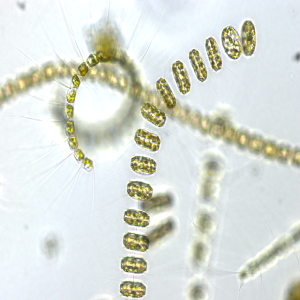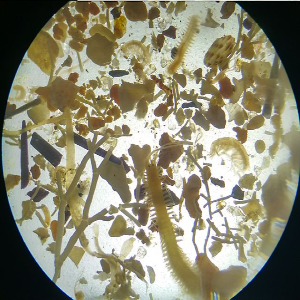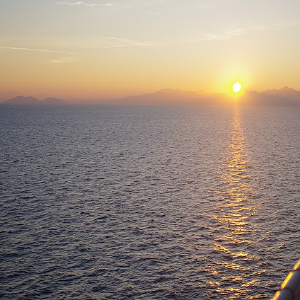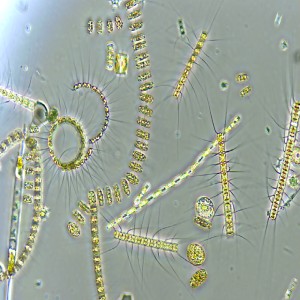Linking ecosystems, habitats, and biodiversity: from the grand picture to the tiny details, and back
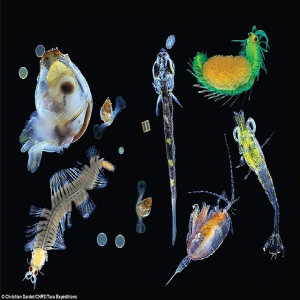
HTML: 42
All claims expressed in this article are solely those of the authors and do not necessarily represent those of their affiliated organizations, or those of the publisher, the editors and the reviewers. Any product that may be evaluated in this article or claim that may be made by its manufacturer is not guaranteed or endorsed by the publisher.
Natural sciences usually proceed through the analysis of facts that are then assembled into a general framework, often called a “theory”. I have tried here to assemble the “tiny facts” that I have uncovered in my career and to organize them into a holistic perspective. I have chosen to start from the “big picture”, i.e., the functioning of ecosystems, to focus then on details regarding the expression of biodiversity, from the role of life cycles in ecosystem functioning, to the way of assessing biodiversity based on the accurate knowledge of its evolution in time. The Historical Biodiversity Index allows to compare the potential biodiversity (all the species recorded from the studied habitat type) with the realized biodiversity (the species found by sampling in that habitat). The study of natural history might lead to unexpected ecological connections, such as the dynamics of plankton (the most important ecological phenomenon of the whole planet) and the composition of resting stage banks, or the keystone role of the interstitial fauna in determining the diversity of plankton. The oceanic realm is in three dimensions and must be considered as a volume rather than as an area. Living systems, though, change constantly and a fourth dimension (time) is crucial to understand their structure and function. The cells of ecosystem functioning, based on connectivity, are proposed as natural spatial units for both management and protection from human impacts.
Arnaud S, Arvanitidis C, Azollini R, Austen M, Balguerias E, Boero F, et al., 2013. Navigating the Future IV. Position Paper 20 of the European Marine Board. Ostend, Belgium. 203 pp.
Belmonte G, Castello P, Piccinni MR, Quarta S, Rubino F, Geraci S, Boero F, 1995. Resting stages off the Italian coast. In A Elefteriou, AD Ansell, CJ Smith (Eds). Biology and ecology of Shallow Coastal Waters. Olsen & Olsen, Fredensborg, Denmark. p. 53-58.
Boero F, 1994. Fluctuations and variations in coastal marine environments. P.S.Z.N.I: Marine Ecology 15:3-25. DOI: https://doi.org/10.1111/j.1439-0485.1994.tb00038.x
Boero F, 1996. Episodic events: their relevance in ecology and evolution. P.S.Z.N.I: Marine Ecology 17:237-250. DOI: https://doi.org/10.1111/j.1439-0485.1996.tb00505.x
Boero F, 2001. Light after dark: the partnership for enhancing expertise in taxonomy. Trends in Ecology and Evolution 16:266. DOI: https://doi.org/10.1016/S0169-5347(01)02133-4
Boero F, 2002. Ship-driven biological invasions in the Mediterranean Sea. IN: Alien marine organisms introduced by ships in the Mediterranean and Black Seas. CIESM Workshop Monographs 20:87-91.
Boero F, 2008. Price and value, alternatives to biodiversity conservation (in the seas). CIESM Workshop Monograph 37:61-64.
Boero F, 2010. The study of species in the era of biodiversity: a tale of stupidity. Diversity 2:115-126. DOI: https://doi.org/10.3390/d2010115
Boero F, 2013. Review of jellyfish blooms in the Mediterranean and Black Sea. GFCM Studies and Reviews 92: 53 pp.
Boero F, 2015a. From Darwin’s Origin of Species towards a theory of natural history. F1000 Prime Reports, 7:49. DOI: https://doi.org/10.12703/P7-49
Boero F, 2015b. The future of the Mediterranean Sea ecosystem: towards a different tomorrow. Rendiconti Lincei 26:3-12. DOI: https://doi.org/10.1007/s12210-014-0340-y
Boero F, 2016. Marine Biodiversity and ecosystem functioning: the pillars of Good Environmental Status. Biologia Marina Mediterranea 23:50-57.
Boero F, 2017. From Marine Protected Areas to MPA Networks. In: P Goriup (ed). Management of Marine Protected Areas. A Network Perspective. Wiley and Sons, Chichester, UK. p. 1-20. DOI: https://doi.org/10.1002/9781119075806.ch1
Boero F, 2021a. Mission possible: holistic approaches can heal marine wounds. Adv. Mar. Biol. 88:19-38. DOI: https://doi.org/10.1016/S0065-2881(21)00016-X
Boero F, 2021b. The future ocean we want. Advances in Marine Biology 90:51-63. DOI: https://doi.org/10.1016/bs.amb.2021.07.001
Boero F, Belmonte G, Fanelli G, Piraino S, Rubino F, 1996. The continuity of living matter and the discontinuities of its constituents: do plankton and benthos really exist? Trends in Ecology and Evolution 11:177-180. DOI: https://doi.org/10.1016/0169-5347(96)20007-2
Boero F, Belmonte G, Bussotti S, Fanelli G, Fraschetti S, Giangrande A, et al., 2004. From biodiversity and ecosystem functioning to the roots of ecological complexity. Ecological Complexity 2:101-109. DOI: https://doi.org/10.1016/j.ecocom.2004.01.003
Boero F, Bernardi G, 2014. Phenotypic vs genotypic approaches to biodiversity, from conflict to alliance. Marine Genomics 17:63-64. DOI: https://doi.org/10.1016/j.margen.2014.03.005
Boero F, Bonsdorff E, 2007. A conceptual framework for marine biodiversity and ecosystem functioning. Marine Ecology-An evolutionary perspective 28:134-145. DOI: https://doi.org/10.1111/j.1439-0485.2007.00171.x
Boero F, Bouillon J, Gravili C, Miglietta MP, Parsons T, Piraino S, 2008. Gelatinous plankton: irregularities rule the world (sometimes). Mar. Ecol. Progr. Ser. 356:299-310. DOI: https://doi.org/10.3354/meps07368
Boero F, Foglini, F, Fraschetti S, Goriup P, Machpherson E, Planes S, Soukissian T, CoCoNet Consortium. 2016. CoCoNet: towards coast to coast networks of Marine Protected Areas (from the shore to the high and deep sea), coupled with sea-based wind energy potential. SCI-RES.IT 6:1-95.
Boero F, De Leo F, Fraschetti S, Ingrosso G, 2019. The Cells of Ecosystem Functioning: towards a holistic vision of marine space. Advances in Marine Biology 82:129-153. DOI: https://doi.org/10.1016/bs.amb.2019.03.001
Boero F, Kraberg, AC, Krause G, Wiltshire KH, 2015. Time is an affliction: why ecology cannot be as predictive ad physics and why it needs time series. Journal of Sea Research 101:12-18. DOI: https://doi.org/10.1016/j.seares.2014.07.008
Boero F, Cummins V, Gault J, Huse G, Philippart C, Schneider R, et al., 2019b. Navigating the Future V: Marine Science for a Sustainable Future. Position paper of the European Marine Board, Ostend, Belgium. 24:1-89.
Boero F, Carlton J, Briand F, Kiessling W, Chenuil A, Voultsiadou E, et al., 2013. Marine Extinctions. Patterns and Processes. CIESM Workshop Monographs 45:5-19.
Boero F., Di Camillo C., Gravili C. 2005. Aquatic invasions: phantom aliens in Mediterranean waters. MarBEF Newsletter 3, 21–22.
Boero F, Fresi E, 1986. Zonation and evolution of a rocky bottom hydroid community. P.S.Z.N.I: Marine Ecology 7:123-150. DOI: https://doi.org/10.1111/j.1439-0485.1986.tb00152.x
Boero F, Gravili C, 2013. The bio-ecology of marine extinctions, with a lesson from the Hydrozoa. CIESM Workshop Monographs 45:75-79.
Bouillon J, Medel MD, Pagès F, Gili JM, Boero F, Gravili C, 2004. Fauna of the Mediterranean Hydrozoa. Scientia Marina 68:1-449. DOI: https://doi.org/10.3989/scimar.2004.68s25
Bouillon J, Gravili C, Pagès F, Gili J-M, Boero F, 2006. An Introduction to Hydrozoa. Mémoires du Musèum national d'Histoire naturelle. Paris, France: Muséum National d'Histoire Naturelle. 598 pp.
Britten GL, Dowd M, Minto C, Ferretti F, Boero F, Lotze HK, 2014. Predator decline leads to decreased stability in a coastal fish community. Ecology Letters 17:1518-1525. DOI: https://doi.org/10.1111/ele.12354
Costello MJ, Emblow C, White RJ (Eds), 2001. European register of marine species: a check-list of the marine species in Europe and a bibliography of guides to their identification. Collection Patrimoines Naturels, 50. Muséum National d'Histoire Naturelle: Paris, France. 463 pp.
Fauvel P, 1901. Les variations de la faune marine. Feuille des jeunes naturalistes 363:78-81.
Della Croce N, Boero F, 1976. Ecologia e biologia dei porti del Mar Ligure e Alto Tirreno. Aspetti termici del Golfo di La Spezia. IIIes Journées d’Etudes Pollutions: 125-131.
Fraschetti S, Giangrande A, Terlizzi A, Boero F, 2003. Pre- and post-settlement events in hard- and soft-bottom community dynamics. Oceanologica Acta 25:285-296. DOI: https://doi.org/10.1016/S0399-1784(02)01194-5
Fraschetti S, Terlizzi A, Boero F, 2008. How Many habitats are there in the sea (and where)? Journal of Experimental Marine Biology and Ecology 366:109-115. DOI: https://doi.org/10.1016/j.jembe.2008.07.015
Gravili C, Bevilacqua S, Terlizzi A, Boero F, 2015. Missing species among Mediterranean non-Siphonophoran Hydrozoa. Biodiversity and Conservation 24:1329–1357. DOI: https://doi.org/10.1007/s10531-015-0859-y
Heip C, Hummel H, van Avesaath P, Appeltans W, Arvanitidis C, Aspden R, et al., 2009. Marine Biodiversity and Ecosystem Functioning. Printbase, Dublin, Ireland. 91 pp.
Marcus N, Boero F, 1998. Production and Plankton Community Dynamics in Coastal Aquatic Systems: The Importance of Benthic-Pelagic Coupling and The Forgotten Role Of Life Cycles. Limnology and Oceanography 43:763-768. DOI: https://doi.org/10.4319/lo.1998.43.5.0763
Parenzan P, 1934. Rotazione Biologica Naturale. Bollettino di Zoologia 5:137-144. DOI: https://doi.org/10.1080/11250003409426267
Pati AC, Belmonte G, Ceccherelli VU, Boero F, 1999. The inactive temporary component: an unexplored fraction of meiobenthos. Marine Biology 134:419-427. DOI: https://doi.org/10.1007/s002270050558
Piraino S, Aglieri G, Martell L, Mazzoldi C, Melli V, Milisenda G., et al., 2014. Pelagia benovici sp.nov. (Cnidaria, Scyphozoa): a new jellyfish in the Mediterranean Sea. Zootaxa 3794:455-468. DOI: https://doi.org/10.11646/zootaxa.3794.3.7
Puce S, Bavestrello G, Di Camillo CG, Boero F, 2009. Long-term changes in hydroid (Cnidaria Hydrozoa) assemblages: effect of Mediterranean warming? Marine Ecology-An evolutionary perspective 30:313-326. DOI: https://doi.org/10.1111/j.1439-0485.2009.00283.x
Rivetti I, Fraschetti S, Lionello P, Zambianchi E, Boero F, 2014. Global warming and mass mortalities of benthic invertebrates in the Mediterranean Sea. PLoS ONE 9:e115655. DOI: https://doi.org/10.1371/journal.pone.0115655
Scorrano S, Aglieri G, Boero F, Dawson MN, Piraino S, 2017. Unmasking Aurelia species in the Mediterranean Sea: an integrative morphometric and molecular approach. Zoological Journal of the Linnean Society 180:243-267. DOI: https://doi.org/10.1111/zoj.12494
Copyright (c) 2022 The Author(s)

This work is licensed under a Creative Commons Attribution-NonCommercial 4.0 International License.
PAGEPress has chosen to apply the Creative Commons Attribution NonCommercial 4.0 International License (CC BY-NC 4.0) to all manuscripts to be published.



 https://doi.org/10.4081/aiol.2022.11079
https://doi.org/10.4081/aiol.2022.11079




